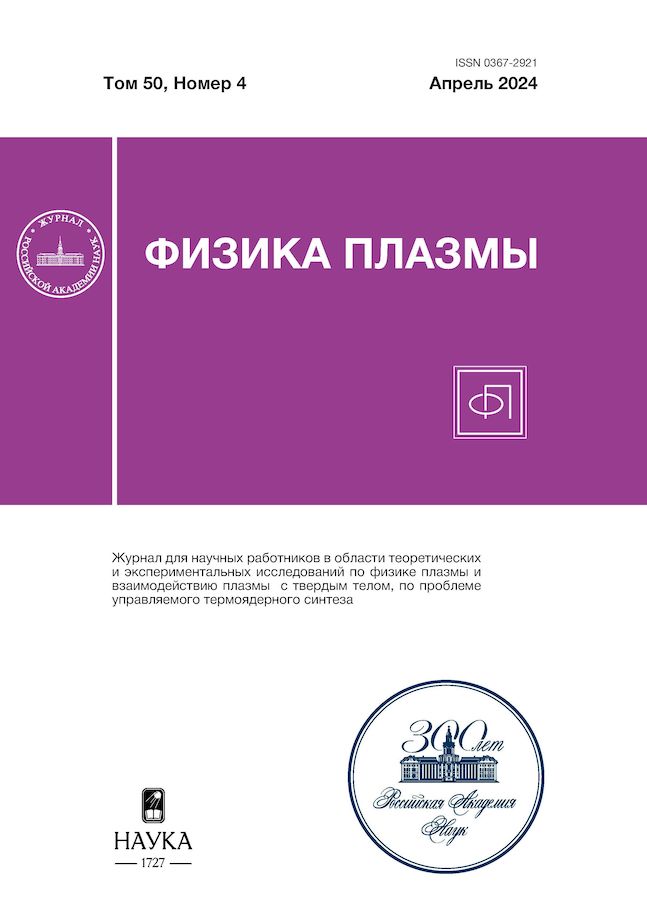Conceptual Project for Diagnostics of Erosion of the First Wall and Divertor of the Tokamak with Reactor Technologies TRT
- Autores: Razdobarin A.G.1,2,3, Shubin Y.R.1, Belokur A.A.1, Bogachev D.L.2, Elets D.I.1,2,3, Medvedev O.S.1,2,3, Mukhin E.E.1, Snigirev L.A.1, Alekseenko I.V.3
-
Afiliações:
- Ioffe Institute, Russian Academy of Sciences
- Spectral-Tech
- Immanuel Kant Baltic Federal University
- Edição: Volume 50, Nº 4 (2024)
- Páginas: 409-426
- Seção: TOKAMAKS
- URL: https://cardiosomatics.ru/0367-2921/article/view/668781
- DOI: https://doi.org/10.31857/S0367292124040042
- EDN: https://elibrary.ru/QDRKLY
- ID: 668781
Citar
Texto integral
Resumo
A conceptual design for diagnosing erosion of the first wall and divertor plates of a tokamak with reactor technologies TRT is proposed. The principles of constructing a diagnostic complex based on the following systems are developed: laser radar, dual-wavelength digital holographic interferometry and active laser IR thermography. An optical scheme is developed for combining the optical paths to input laser radiation and collect scattered light from diagnostic systems. To view the maximum area of the first wall, a scheme for optical scanning of the surface of the first wall and divertor is proposed. Based on optical simulation, the spatial distribution of the power density and phase of interferometry laser radiation in the illuminated region of the first wall is constructed, and the dimensions of the light fields and power density for IR thermography and laser radar diagnostics are determined. An image formation scheme is proposed and the spatial resolution is determined for interferometry and IR thermography methods. The light scattering function on models of the ITER divertor cladding is studied experimentally. The energy of the collected signal is calculated on the basis on the experimental data for all three diagnostic methods and the requirements for the diagnostic equipment are formulated.
Palavras-chave
Sobre autores
A. Razdobarin
Ioffe Institute, Russian Academy of Sciences; Spectral-Tech; Immanuel Kant Baltic Federal University
Autor responsável pela correspondência
Email: Aleksey.Razdobarin@mail.ioffe.ru
Rússia, St. Petersburg, 194021; St. Petersburg, 194223; Kaliningrad, 236041
Y. Shubin
Ioffe Institute, Russian Academy of Sciences
Email: Aleksey.Razdobarin@mail.ioffe.ru
Rússia, St. Petersburg, 194021
A. Belokur
Ioffe Institute, Russian Academy of Sciences
Email: Aleksey.Razdobarin@mail.ioffe.ru
Rússia, St. Petersburg, 194021
D. Bogachev
Spectral-Tech
Email: Aleksey.Razdobarin@mail.ioffe.ru
Rússia, St. Petersburg, 194223
D. Elets
Ioffe Institute, Russian Academy of Sciences; Spectral-Tech; Immanuel Kant Baltic Federal University
Email: Aleksey.Razdobarin@mail.ioffe.ru
Rússia, St. Petersburg, 194021; St. Petersburg, 194223; Kaliningrad, 236041
O. Medvedev
Ioffe Institute, Russian Academy of Sciences; Spectral-Tech; Immanuel Kant Baltic Federal University
Email: Aleksey.Razdobarin@mail.ioffe.ru
Rússia, St. Petersburg, 194021; St. Petersburg, 194223; Kaliningrad, 236041
E. Mukhin
Ioffe Institute, Russian Academy of Sciences
Email: Aleksey.Razdobarin@mail.ioffe.ru
Rússia, St. Petersburg, 194021
L. Snigirev
Ioffe Institute, Russian Academy of Sciences
Email: Aleksey.Razdobarin@mail.ioffe.ru
Rússia, St. Petersburg, 194021
I. Alekseenko
Immanuel Kant Baltic Federal University
Email: Aleksey.Razdobarin@mail.ioffe.ru
Rússia, Kaliningrad, 236041
Bibliografia
- De Temmerman G., Hirai T., Pitts R. A. // Plasma Phys. Control. Fusion. 2018. V. 60, P. 044018. https://doi.org/10.1088/1361—6587/aaaf62
- Schweer B., Huber A., Sergienko G., Philipps V., Irrek F., Esser H. G., Samm U., Kempenaars M., Stamp M., Gowers C., Richards D. // J. Nucl. Mater. 2005. V. 337—339. P. 570. https://doi.org/10.1016/j.jnucmat.2004.10.156
- Pintsuk G., Bobin-Vastra I., Constans S., Gavila P., Rödig M., Riccardi B. // Fusion Eng. Des. 2013. V. 88. P. 1858. https://doi.org/10.1016/j.fusengdes.2013.05.091
- Кукушкин А. С., Пшенов А. А. // Физика плазмы. 2021. Т. 47. № 12. С. 1123.
- Будаев В.П. // ВАНТ. Термоядерный синтез. 2015. Т. 38. № 4. С. 5.
- Autricque A., Peillon S., Gensdarmes F., Sow M., Fedorczak N., Roche H., Pluchery O., Grisolia C. // Nucl. Mater. Energy. 2018. V. 17. P. 284. https://doi.org/10.1016/j.nme.2018.11.013
- Cohen R., Ryutov D. // Physics of Plasmas. 1998. V. 5. P. 2194. https://doi.org/10.1063/1.872926
- Reichle R., Andrew P., Bates P., Bede O., Casal N., Choi C. H., Barnsley R., Damiani C., Bertalot L., Dubus G., Ferreol J., Jagannathan G., Kocan M., Leipold F., Lisgo S. W., Martin V., Palmer J., Pearce R., Philipps V., Pitts R. A., Passedat G., Puiu A., Suarez A., Shigin P., Shu W., Vayakis G., Veshchev E., Walsh M. // Journal of Nuclear Materials, 2015, V. 463, P. 180. https://doi.org/10.1016/j.jnucmat.2015.01.039
- Pedrini G., Calabuig A., Jagannathan G., Kempenaars M., Vayakis G., Osten W. // Applied Optics. 2019. V. 58. Iss. 5. P. A147. https://doi.org/10.1364/AO.58.00A147
- Li Т., Almond D. P. and Rees D. A.S. // Meas. Sci. Technol. 2011, 22, 035701. https://doi.org/ 10.1088/0957-0233/22/3/035701
- Courtois X., Sortais C., Melyukov D., Gardarein J. L., Semerok A., Grisolia Ch. // Fusion Engineering and Design. 2011. V. 86, P. 1714. https://doi.org/10.1016/j.fusengdes.2011.04.071
- Cook R. L., Torrance K. E. // ACM SIGGRAPH Graphics. 1981. V. 15. Issue 3. P. 307. https://doi.org/10.1145/965161.806819
- Beckmann P., Spizzichino A. The scattering of electromagnetic waves from rough surfaces. Norwood MA, Artech House Inc., 1987.
- Schlick C. // Computer graphics forum. 1994. V. 13. № 3. P. 233. https://doi.org/10.1111/1467-8659.1330233
- Werner W. S. M., Glantschnig K., Ambrosch-Draxl C. //Journal of Physical and Chemical Reference Data. 2009. V. 38. № 4. P. 1013. doi: 10.1063/1.3243762
- Litnovsky A., Wienhold P., Philipps V., Sergienko G., Schmitz O., Kirschner A., Kreter A., Droste S., Samm U., Mertens Ph., Donné A. H., TEXTOR Team, Rudakov D., Allen S., Boivin R., McLean A., Stangeby P., West W., Wong C., DIII-D Team, Romanyuk A. // J. Nucl. Mat. 2007. V. 363—365. P. 1395.
- http://www.lightsensing.com/
- Бондаренко А. В., Высоцкий Д. В., Тугаринов С. Н. // ВАНТ. Термоядерный синтез. 2018. Т. 41. № 1. С. 18.
Arquivos suplementares










